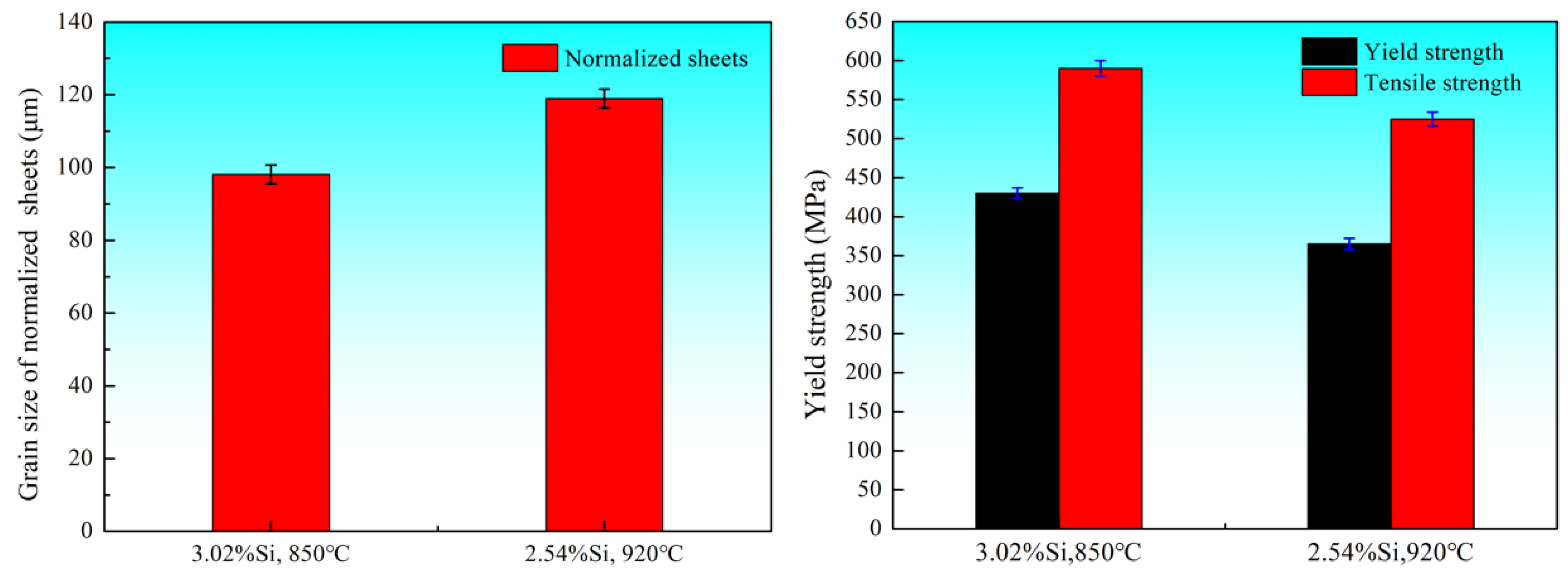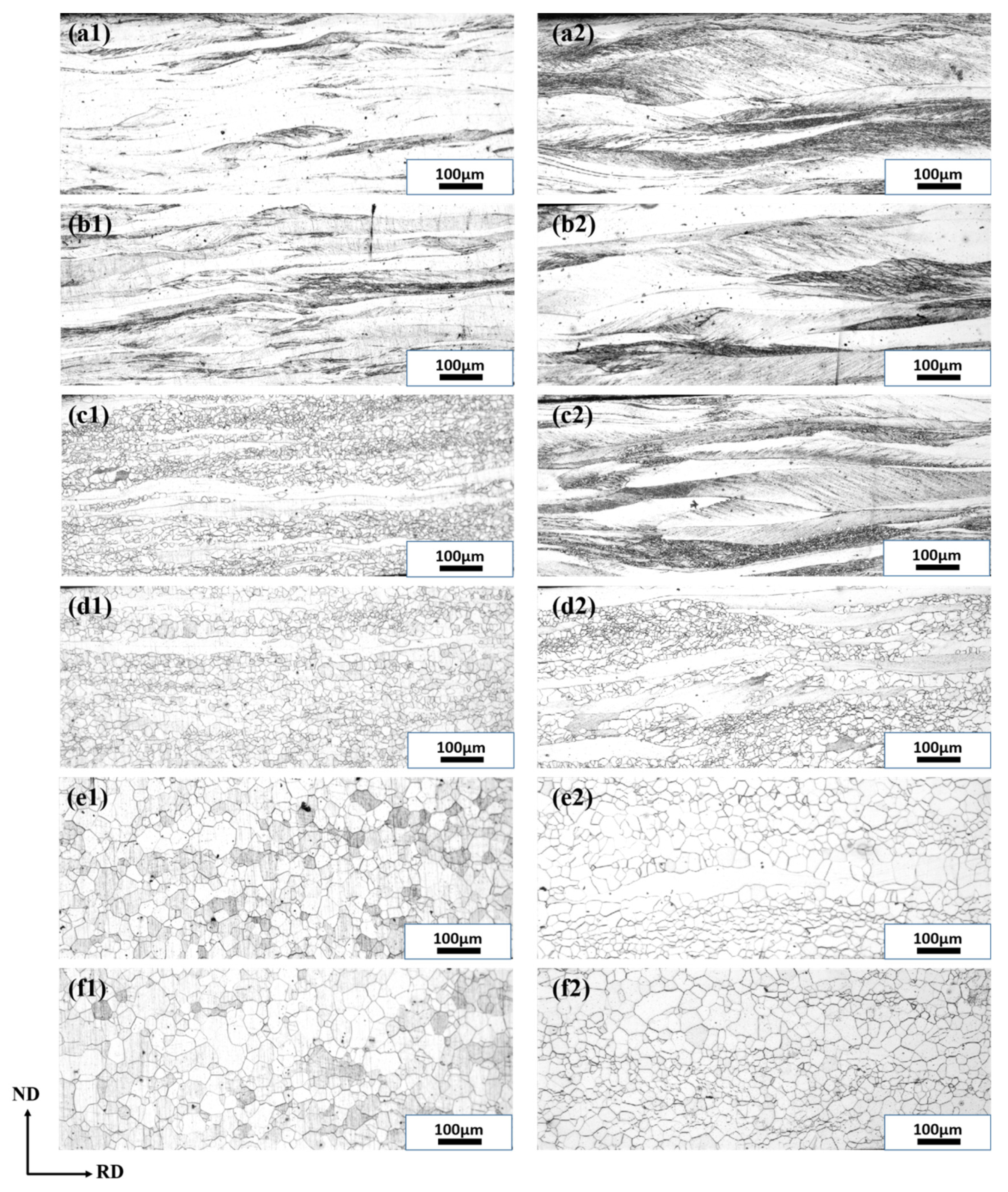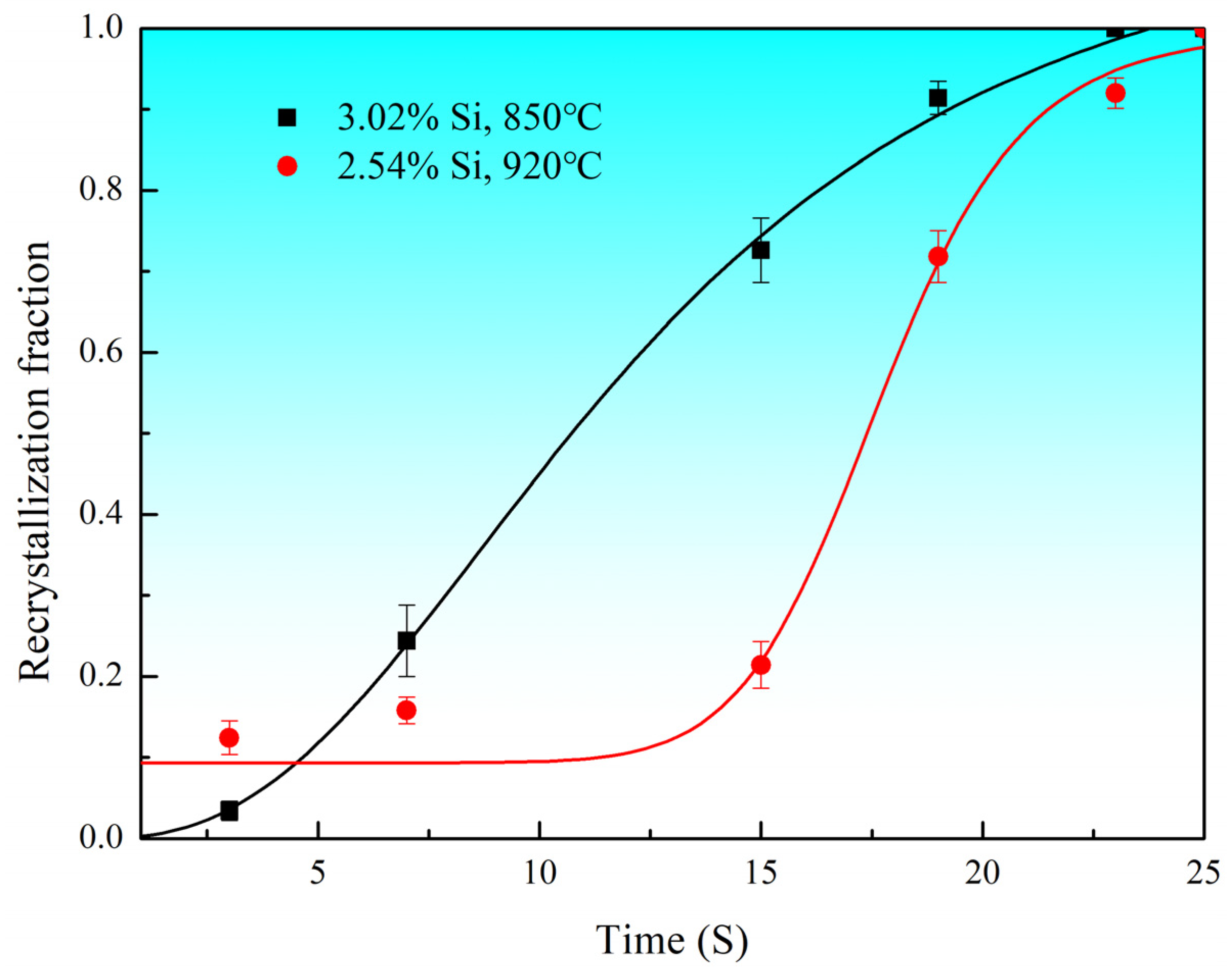Roles of Silicon Content and Normalization Temperature on Cold Workability and Recrystallization of High-Grade Non-Oriented Silicon Steel
Abstract
:1. Introduction
2. Materials and Methods
3. Results
3.1. Microstructure and Macro-Texture of High-Grade Non-Oriented Silicon Steel Initial Hot Rolled Sheet with Different Si Content
3.2. Microstructure and Macro-Texture and Mechanical Properties of High-Grade Non-Oriented Silicon Steel Normalized Sheets with Different Si Content at Different Normalization Temperature
4. Discussion
4.1. Role of Silicon Content on Hot-Rolled Microstructure and Texture of High-Grade Non-Oriented Silicon Steel
4.2. Role of Silicon Content and Normalization Temperature on Recrystallization Kinetics of High-Grade Non-Oriented Silicon Steel
5. Conclusions
- (1)
- Si hindered recrystallization and increased deformation resistance. When Si content decreased, recrystallization ratio, recrystallized grain size and Goss texture intensity at the surface layer of high-grade non-oriented silicon steel hot rolled sheet increased, but α-fiber texture intensity at the center layer reduced.
- (2)
- When the Si content decreased, tensile strength and yield strength of the normalized sheet were reduced by 65 MPa simultaneously; this method was able to decrease the cold rolling workability evidently of high-grade non-oriented silicon steel.
- (3)
- Lower Si content and higher normalization temperature cold-rolled sheet had more shear bands that nucleated earlier but the process of recrystallization was slower, resulting in a more heterogeneous grain size distribution in the final annealing sheet.
Supplementary Materials
Author Contributions
Funding
Institutional Review Board Statement
Informed Consent Statement
Data Availability Statement
Conflicts of Interest
References
- Petrun, M.; Steentjes, S. Iron-loss and magnetization dynamics in non-oriented electrical steel: 1-D excitations up to high frequencies. IEEE Access 2020, 8, 4568–4593. [Google Scholar] [CrossRef]
- Barros, J.; Ros-Yanez, T.; Vandenbossche, L.; Dupré, L.; Melkebeek, J.; Houbaert, Y. The effect of Si and Al concentration gradients on the mechanical and magnetic properties of electrical steel. J. Magn. Magn. Mater. 2005, 290, 1457–1460. [Google Scholar] [CrossRef]
- Ban, G.; Nemeth, S.; Arato, P. Composition effects on core loss of Fe-Si-Al electrical steels. IEEE Trans. Magn. 1987, 23, 3227–3229. [Google Scholar] [CrossRef]
- Ros-Yáñez, T.; Ruiz, D.; Barros, J.; Houbaert, Y. Advances in the production of high-silicon electrical steel by thermomechanical processing and by immersion and diffusion annealing. J. Alloys Compd. 2004, 369, 125–130. [Google Scholar] [CrossRef]
- Moseley, D.; Hu, Y.; Randle, V.; Irons, T. Role of silicon content and final annealing temperature on microtexture and microstructure development in non-oriented silicon steel. Mater. Sci. Eng. A 2005, 392, 282–291. [Google Scholar] [CrossRef]
- An, L.Z.; Wang, Y.; Song, H.Y.; Wang, G.-D.; Liu, H.-T. Improving magnetic properties of non-oriented electrical steels by controlling grain size prior to cold rolling. J. Magn. Magn. Mater. 2019, 491, 165636. [Google Scholar] [CrossRef]
- Park, J.T.; Szpunar, J.A. Effect of initial grain size on texture evolution and magnetic properties in nonoriented electrical steels. J. Magn. Magn. Mater. 2009, 321, 1928–1932. [Google Scholar] [CrossRef]
- Shiozaki, M.; Kurosaki, Y. The effects of grain size on the magnetic properties of non-oriented electrical steel sheets. J. Mater. Eng. 1989, 11, 37–43. [Google Scholar] [CrossRef]
- Li, Z.H.; Xie, S.K.; Wang, G.D.; Liu, H.-T. Dependence of recrystallization behavior and magnetic properties on grain size prior to cold rolling in high silicon non-oriented electrical steel. J. Alloys Compd. 2021, 888, 161576. [Google Scholar] [CrossRef]
- Liang, Y.F.; Ye, F.; Lin, J.P.; Wang, Y.L.; Chen, G.L. Effect of annealing temperature on magnetic properties of cold rolled high silicon steel thin sheet. J. Alloys Compd. 2010, 491, 268–270. [Google Scholar] [CrossRef]
- Li, Z.; Xie, S.; Wang, G.; Liu, H.-T. Ultrathin-gauge high silicon non-oriented electrical steel with high permeability and low core loss fabricated by optimized two-stage cold rolling method. Mater. Charact. 2022, 183, 111593. [Google Scholar] [CrossRef]
- Cai, G.; Li, C.; Cai, B.; Wang, Q. An investigation on the role of texture evolution and ordered phase transition in soft magnetic properties of Fe–6.5 wt% Si electrical steel. J. Magn. Magn. Mater. 2017, 430, 70–77. [Google Scholar] [CrossRef]
- Mehdi, M.; He, Y.; Hilinski, E.J.; Kestens, L.A.; Edrisy, A. The evolution of cube ({001}<100>) texture in non-oriented electrical steel. Acta Mater. 2020, 185, 540–554. [Google Scholar]
- Sidor, Y.; Kovac, F. Microstructural aspects of grain growth kinetics in non-oriented electrical steels. Mater. Charact. 2005, 55, 1–11. [Google Scholar] [CrossRef]
- Fang, F.; Xu, Y.B.; Zhang, Y.X.; Wang, Y.; Lu, X.; Misra, R.; Wang, G.-D. Evolution of recrystallization microstructure and texture during rapid annealing in strip-cast non-oriented electrical steels. J. Magn. Magn. Mater. 2015, 381, 433–439. [Google Scholar] [CrossRef]
- Zu, G.; Xu, Y.; Luo, L.; Han, Y.; Sun, S.; Miao, R.; Zhu, W.; Gao, L.; Ran, X. Effect of rolling temperature on the recrystallization behavior of 4.5 wt.% Si non-oriented electrical steel. J. Mater. Res. Technol. 2022, 17, 365–373. [Google Scholar] [CrossRef]
- Džubinský, M.; Sidor, Y.; Kováč, F. Kinetics of columnar abnormal grain growth in low-Si non-oriented electrical steel. Mater. Sci. Eng. A 2004, 385, 449–454. [Google Scholar] [CrossRef]
- Jiao, H.T.; Xu, Y.B.; Zhao, L.Z.; Misra, R.; Tang, Y.; Zhao, M.; Liu, D.; Hu, Y.; Shen, M. Microstructural evolution and magnetic properties in strip cast non-oriented silicon steel produced by warm rolling. Mater. Charact. 2019, 156, 109876. [Google Scholar] [CrossRef]
- Da Costa Paolinelli, S.; da Cunha, M.A.; Cota, A.B. The influence of shear bands on final structure and magnetic properties of 3% Si non-oriented silicon steel. J. Magn. Magn. Mater. 2008, 320, e641–e644. [Google Scholar] [CrossRef] [Green Version]
- De Dafe, S.S.F.; da Costa Paolinelli, S.; Cota, A.B. Influence of thermomechanical processing on shear bands formation and magnetic properties of a 3% Si non-oriented electrical steel. J. Magn. Magn. Mater. 2011, 323, 3234–3238. [Google Scholar] [CrossRef]






| Number | C | Si | Al | Mn | Ti | N | S | Note |
|---|---|---|---|---|---|---|---|---|
| 1# | ≤0.0045 | 3.02 | 0.32 | 0.17 | ≤0.0045 | ≤0.0045 | ≤0.0030 | High silicon |
| 2# | ≤0.0045 | 2.54 | 0.35 | 0.15 | ≤0.0045 | ≤0.0045 | ≤0.0030 | Low silicon |
Publisher’s Note: MDPI stays neutral with regard to jurisdictional claims in published maps and institutional affiliations. |
© 2022 by the authors. Licensee MDPI, Basel, Switzerland. This article is an open access article distributed under the terms and conditions of the Creative Commons Attribution (CC BY) license (https://creativecommons.org/licenses/by/4.0/).
Share and Cite
Lin, Y.; Wang, H.; Wang, S.; Zhang, W.; Wang, L.; Feng, Z.; Wang, Y. Roles of Silicon Content and Normalization Temperature on Cold Workability and Recrystallization of High-Grade Non-Oriented Silicon Steel. Crystals 2022, 12, 593. https://doi.org/10.3390/cryst12050593
Lin Y, Wang H, Wang S, Zhang W, Wang L, Feng Z, Wang Y. Roles of Silicon Content and Normalization Temperature on Cold Workability and Recrystallization of High-Grade Non-Oriented Silicon Steel. Crystals. 2022; 12(5):593. https://doi.org/10.3390/cryst12050593
Chicago/Turabian StyleLin, Yuan, Hongxia Wang, Shijia Wang, Wenkang Zhang, Lixia Wang, Zhiyuan Feng, and Yide Wang. 2022. "Roles of Silicon Content and Normalization Temperature on Cold Workability and Recrystallization of High-Grade Non-Oriented Silicon Steel" Crystals 12, no. 5: 593. https://doi.org/10.3390/cryst12050593







